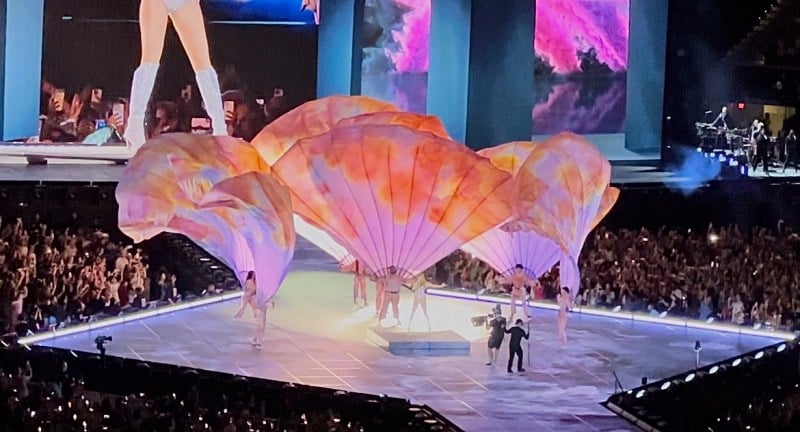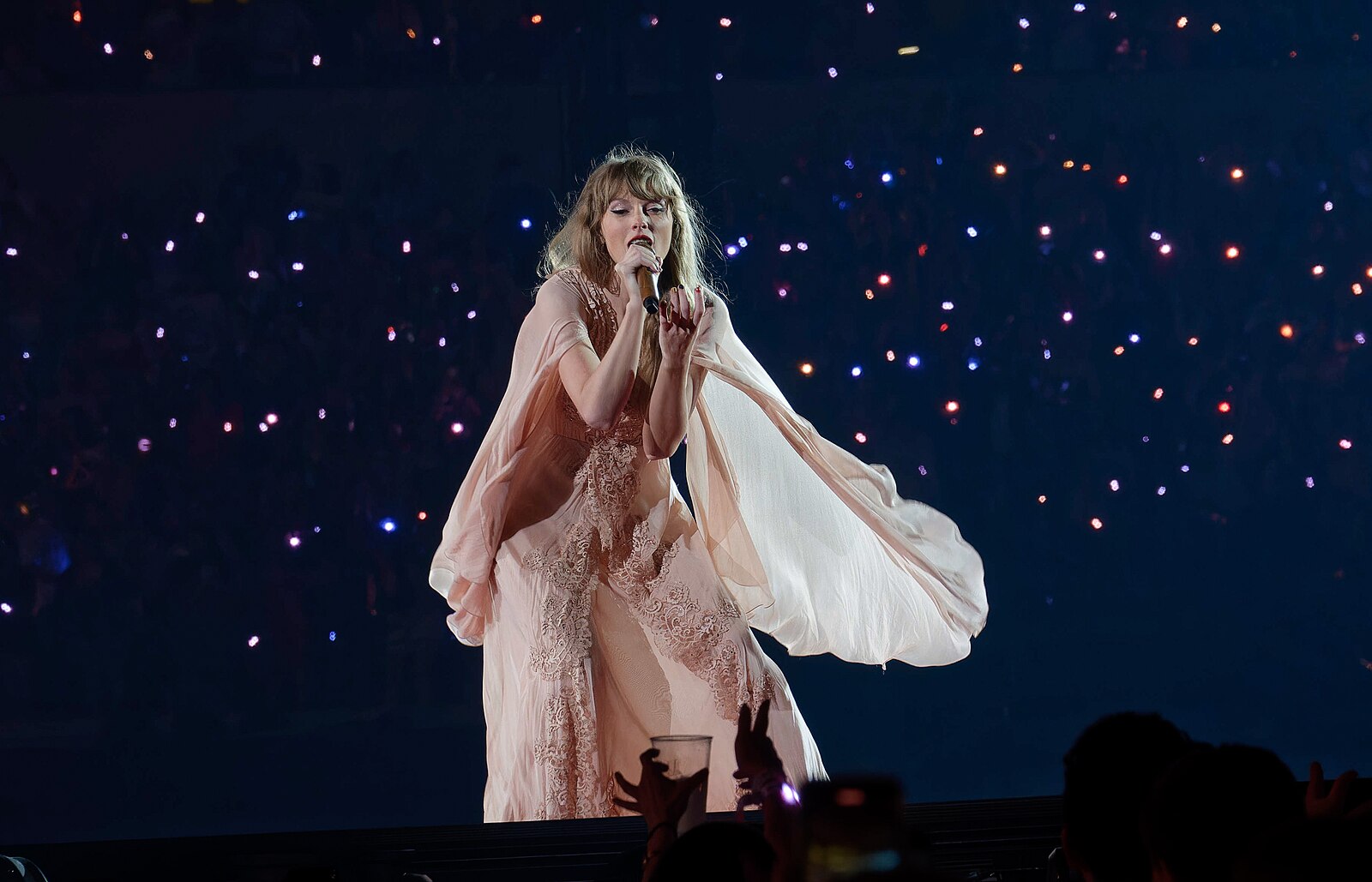We were both young when I first saw her — I close my eyes, and the flashback starts: it’s a school-wide talent show, I am five years old and the four sixth-grade girls singing “Love Story” are the only act that catch my attention. Fast forward fifteen years: last Thursday, I watched Taylor Swift, in a glittering golden fringe dress, perform “Love Story” live at the Eras Tour.
Swiftie or not, many of us have heard the legendary stories of the Eras Tour. Taylor Swift’s sixth concert world tour has brought in over $13 million per night in ticket sales since it started last March, putting it on track to become the highest-grossing tour in history. Tales have been told of the “Swift Quake,” the 2.3 Richter Scale magnitude earthquake caused by fans jumping and dancing during the Seattle performances. Fans have told stories of post-concert amnesia from emotional overload.
This all begs the question: What makes the Eras Tour so legendary? After all, this is not Swift’s first tour, or the first post-pandemic tour from any relevant musical artist. The tour has been going on for almost six months now, and footage has been shared across social media. Ticket prices have been famously high. But fans can’t seem to get enough: pre-sale tickets sold out immediately in November 2022 and extra tour dates were added globally to satisfy popular demand, with the tour set to close its American leg in November 2023.
I believe that the timing of the Eras Tour is a major factor in its success: Having three years of post-pandemic life under their belt, fans can afford to attend an expensive tour and are eager to celebrate making it through COVID.

I was fortunate enough to attend the Eras Tour last Thursday at SoFi Stadium in Los Angeles with my family. Fans were “dressed to the nines” — they wore costumes of all shapes and colors and had their hair and faces adorned with sequins and glitter.
For me, Swift’s opening performance was undoubtedly the most memorable. A string of backup dancers emerged carrying pleated parachutes, billowing in an exquisite heterochromatic palette of peach, pink, lavender and yellow hues. After the dancers spread their parachutes on the floor like flower petals, they lifted them back to reveal Swift blossoming up from the stage, welcomed by ear-shattering screams from fans. In the background was a repeated lyric from “Miss Americana and the Heartbreak Prince,” building up excitement for Swift’s first tour in five years: “It’s been a long time coming.”

This opening was symbolic of Swift’s metamorphosis through the many eras of her 17-year career: from the cute country girl-next-door into the multi-genre musical icon she is today. The three-and-a-half-hour performance of 44 songs was interspersed with 16 costume changes and over 10 set changes spanning Swift’s 10 albums. I couldn’t believe that just the week before, SoFi stadium had hosted a professional soccer game, and now it was the stage for Swift’s visions and dreams coming to life.
In truth, Taylor Swift holds light differently, both figuratively and literally. Based on their seating areas, audience members were provided with LED light wristbands that matched a unique color of the stage and flashed to the rhythm of the song being performed. At times, the lights even outlined the shapes of important symbols within the crowd, such as red hearts during the chorus of her song “Lover.”
Such intentional arrangements brought order to what could have been in danger of being an overwhelming mix of vocals, props and flashing lights. From the front row to the farthest nosebleeds in the back, we were all pieces in the masterful jigsaw puzzle of her concert’s choreography.
Of course, none of this would have worked without the genius of Swift’s storytelling through body language. Whether it was through the toss of a cape, an enigmatic side grin or a fall to her knees, Swift magnetically commanded my attention onto her figure on the center stage. Her emotionality and body language helped bring life and clarity to songs that I thought I knew, but never fully internalized before.
One example was how she both sang and narrated “the 1” from the album “folklore.” Splayed out on the roof of a cabin covered with green moss, Swift sang dreamily about a romance that fizzled out: “But it would’ve been fun / if you would’ve been the one.” She drew out the endings of certain lyrics and ended with a lovelorn sigh and upwards gaze that left audience members screaming.
Other times, Swift explicitly disclosed the storyline to the audience. I especially appreciated this for her popular song “august,” which I always misconstrued as being about the nostalgia of the last month of summer. As Swift explained, it’s actually one song of the three-track set from “folklore” — the other two being “cardigan” and “betty” — that tells the story of a teenage love triangle from three different perspectives.
Swift’s notoriety as a love song writer can be a turn-off for some, but her songs hit on relatable themes beyond romantic love. I walked out of SoFi stadium with a new favorite from Swift: “marjorie,” a tribute to her late grandmother, who was an opera singer. This song touches on Swift’s appreciation of her grandmother’s kindness and wisdom, as well as the many shades of grief that come with loss. This song’s closing even features Marjorie’s voice singing along with Swift, making it a true masterpiece.
Along similar lines, Swift sang in her ballad “The Archer” about not being able to trust anyone, including oneself: “They see right through me … can you see right through me … I see right through me.” The song might be romantic overall, but the feelings of insecurity and fragility are universal. That Thursday night, just about every voice in the audience joined her haunting but cathartic chant; no one was too shy to be vulnerable. Swift’s ability to bond thousands of strangers in a single stadium was astounding.
Perhaps it was this shared vulnerability that created the camaraderie among us audience members. During the performance of “Vigilante Shit,” where Swift and other performers danced seductively on chairs, I found myself feeding off the enthusiasm of a nearby concert goer who turned around and sang the lyrics from memory with me.
At every concert on the Eras Tour, Swift pores through the layers of her discography and performs two “surprise songs” that are unique to that specific performance. On Thursday, she delivered “I Can See You,” a flirty song and one of the previously unreleased “From the Vault” tracks of the “Speak Now” album. Her next song was “Maroon,” a popular song from the recent “Midnights” album. The song was a more mature narration of Swift’s passion, which once burned “red” (as in her hit track “Red” earlier in her career) but now calcifies into a deeper, more somber shade of “maroon.” Swift performed these songs acoustically, showcasing the strength of her raw voice — in fact, I never heard her voice break once the entire night.
The surprise songs weren’t the only pleasant surprise of last Thursday’s concert. In an especially unique moment that also brought all of us together under a common sense of humanity, Swift warmly welcomed Bianka Bryant, the six-year-old daughter of late basketball star Kobe Bryant, to the stage when she performed songs from her popular “Red” album. She gave Bryant the “22” hat she was wearing and a long hug, in a very touching moment that spoke volumes about her humility and kindness.
The Eras Tour was no mere concert: it was a celebration of life. In the years since I first became a fan of Taylor Swift, her music has served as a soundtrack to my journey to find myself as a college student and adult — and I’m not alone. Not only did droves of Stanford students support her when she visited Santa Clara earlier this summer, but some of us even curated and helped teach classes dedicated to analyzing her music.
Whether you’re a fan of pop, jazz, rock or indie music, the Eras Tour confirmed that Swift has a song for you. To call her a singer is an understatement. With her ability to match the right words, music and visuals to every feeling imaginable, she may just be one of the greatest modern composers of our generation. She is a true legend of an artist and performer, and I can not wait to see what she does next — in the Eras Tour, and beyond.
Editor’s Note: This article is a review and includes subjective thoughts, opinions and critiques.
